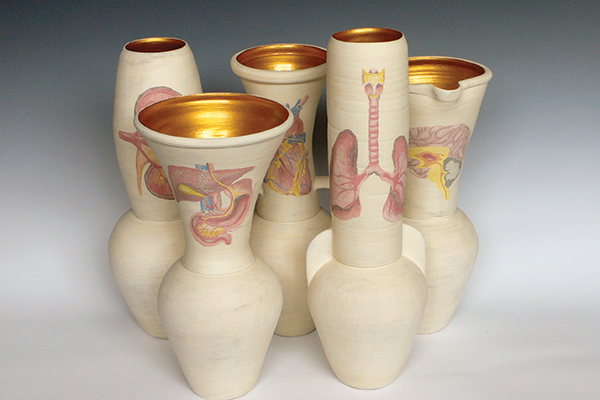Paul Maseyk
One Pot Wonder
Exhibited until 30 November
One Pot Wonder is literally a one-pot wonder, as there is one pot (it stands at about two metres tall), and it makes you wonder. Along with the rest of the survey exhibition, which is equally as wondrous.
The exhibition as a whole is a retrospective of Maseyk’s work from the last 10 years and focuses heavily on the artist’s unique, personal and highly detailed ceramics, highlighting both the finely painted surfaces and the wide sculptural variations.
Maseyk graduated from Wanganui Polytechnic in 1997 and since then, he has become renowned for his use of unique sculptural forms and representations of personal experiences and ideas through complex surface illustrations. He is represented in numerous public collections throughout New Zealand, including Te Papa Tongarewa, The Dowse Art Museum and the Auckland War Memorial Museum, and is currently in the running for the $15,000 National Contemporary Art Award.
Maseyk is nationally renowned for producing ceramic works exploring numerous avenues in terms of style and form, but his signature style of work is significantly concerned with classical Greek forms, elaborated by his contemporary, marvellously surreal designs that animate the surface of each object.
Maseyk has commented on his work, saying that a favourite part of his creative process “has been mimicking Greek amphorae, which had frieze work along the top of the vase and pictures depicting everyday life.” Such motifs of everyday life are exemplified in One Pot Wonder, including: images of crashing planes (corrupt America? He spent time there on scholarship); women; cows; corporate brand logos (Dole and Playboy); and food.
The decorative elaboration on the larger standing works such as One Pot Wonder and Commando Maseyk versus the Zig-Zag Man, is so heavily detailed it is as though the surface is being treated as a canvas. Maseyk even uses liquid coloured clay as paint to do his drawings – I mean, #Mixedmediamaster.
In terms of style and form, it is significant to note that although the ceramic medium offers a starting place, ultimately his work seems resistant to categorisation. His large-scale ceramics share many of sculpture’s concerns – staging a bodily encounter, actively interrupting the viewer’s experience of space, asserting their materiality and form – so, theoretically, I would feel inclined to call them “sculptures,” but sculptures naturally stress surface and form so severely that it almost feels as though calling his works “sculptures” would diminish the finer detailing found in each piece, which I think holds the most value both conceptually and aesthetically. They’re sort of like visual shrines for the artist’s emotions.
Finally, I couldn’t help but recognise the fact that numerous vessels, particularly Big Yellow, Big Orange and Big Blue, which were commissioned specifically for this exhibition, look undeniably similar to certain forms of weed-smoking paraphernalia (a really brightly coloured and shiny bong).
I wonder if Maseyk smokes pot – and whether this aids his surrealistic vision. Surely that kind of detailing doesn’t just stem out of sobriety? Either way, if you’re into pot(s) and brilliant illustrations – you should see this exhibition.



